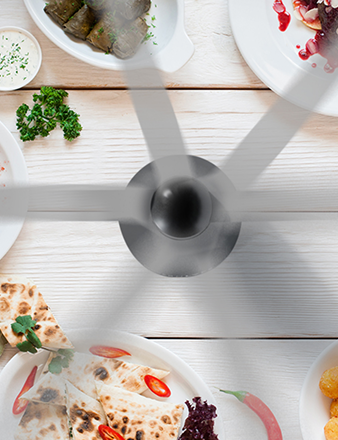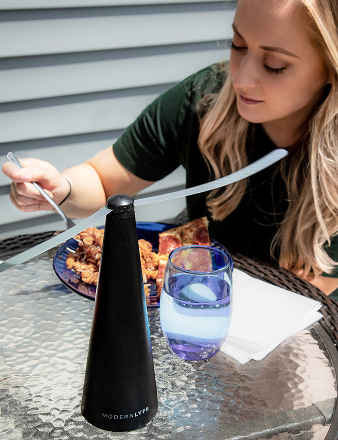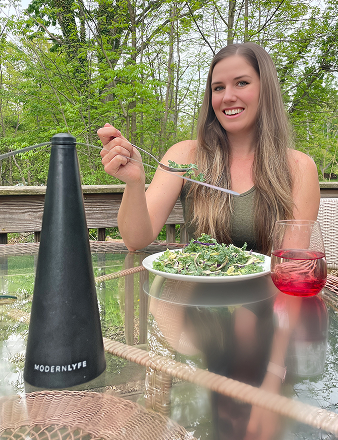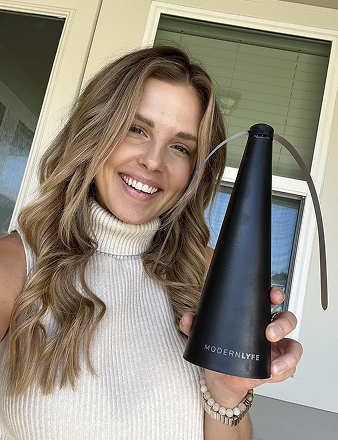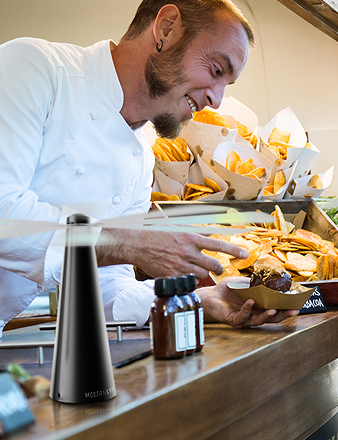To get rid of fruit flies for good, you need a three-part strategy: cut off their food supply, destroy their breeding grounds, and trap the survivors. This straightforward approach disrupts their life cycle and clears them out of your space fast.
Why Fruit Flies Are In Your Space

Fruit flies seem to appear from nowhere, but they don't. They usually hitch a ride into your home as microscopic eggs on fruits and vegetables from the grocery store.
Once inside, they seek out fermenting organic matter to lay their own eggs. This isn't just a household nuisance; it's a major agricultural and economic issue. The U.S. recently faced its worst invasive fruit fly outbreak in 70 years during 2023-2024, requiring a $103.5 million federal response. As this citrus industry update from Farmonaut highlights, these tiny insects cause massive problems.
Common Attractants in Your Home
Fruit flies are drawn to fermenting organic material. To them, your home is full of potential breeding spots. Knowing their favorite hangouts is the first step to getting rid of them.
They are attracted to:
- Overripe Produce: That browning banana bunch or those soft tomatoes on the counter are prime real estate for fruit flies.
- Slow Drains: The gunk inside your kitchen sink drain is a perfect nursery for their larvae.
- Damp Sponges and Dishcloths: A wet cloth left by the sink is an open invitation.
- Trash and Recycling Bins: Small bits of food waste or residue in a soda can are enough to attract a swarm.
The key is realizing you're not just fighting the adult flies. The real battle is against the hundreds of invisible eggs and larvae in these spots. If you don't eliminate their food and breeding sites, you'll never solve the problem.
Your Immediate Action Plan
Before you start a deep clean, take these immediate steps to make a significant dent in the fruit fly population. Acting fast disrupts their life cycle—which is incredibly quick. Two fruit flies can become hundreds in about a week.
Quick Actions to Immediately Reduce Fruit Flies
Here's a table for the most critical first steps. Focus on these tasks as soon as you notice an infestation.
| Action Area | Immediate Task | Why It Works |
|---|---|---|
| Food Sources | Immediately discard or refrigerate all ripe fruit and vegetables on your counters. | Removes the primary attractant and food source for adult flies. |
| Breeding Grounds | Pour boiling water or a mix of baking soda and vinegar down all sink and shower drains. | Kills eggs and larvae thriving in the drain gunk (biofilm). |
| Waste Disposal | Empty all trash and recycling bins, then wipe them down to remove any residue. | Eliminates hidden food scraps and sticky breeding surfaces. |
| Moisture Control | Wring out and hang up all damp cloths, sponges, and mops. Wipe up any spills or standing water. | Removes the moisture flies need to lay their eggs successfully. |
Once you've completed this initial blitz, you’ve broken the cycle. Now you can move on to the thorough cleaning and trapping methods needed to eliminate the remaining adults.
Deep Cleaning to Eradicate Breeding Grounds
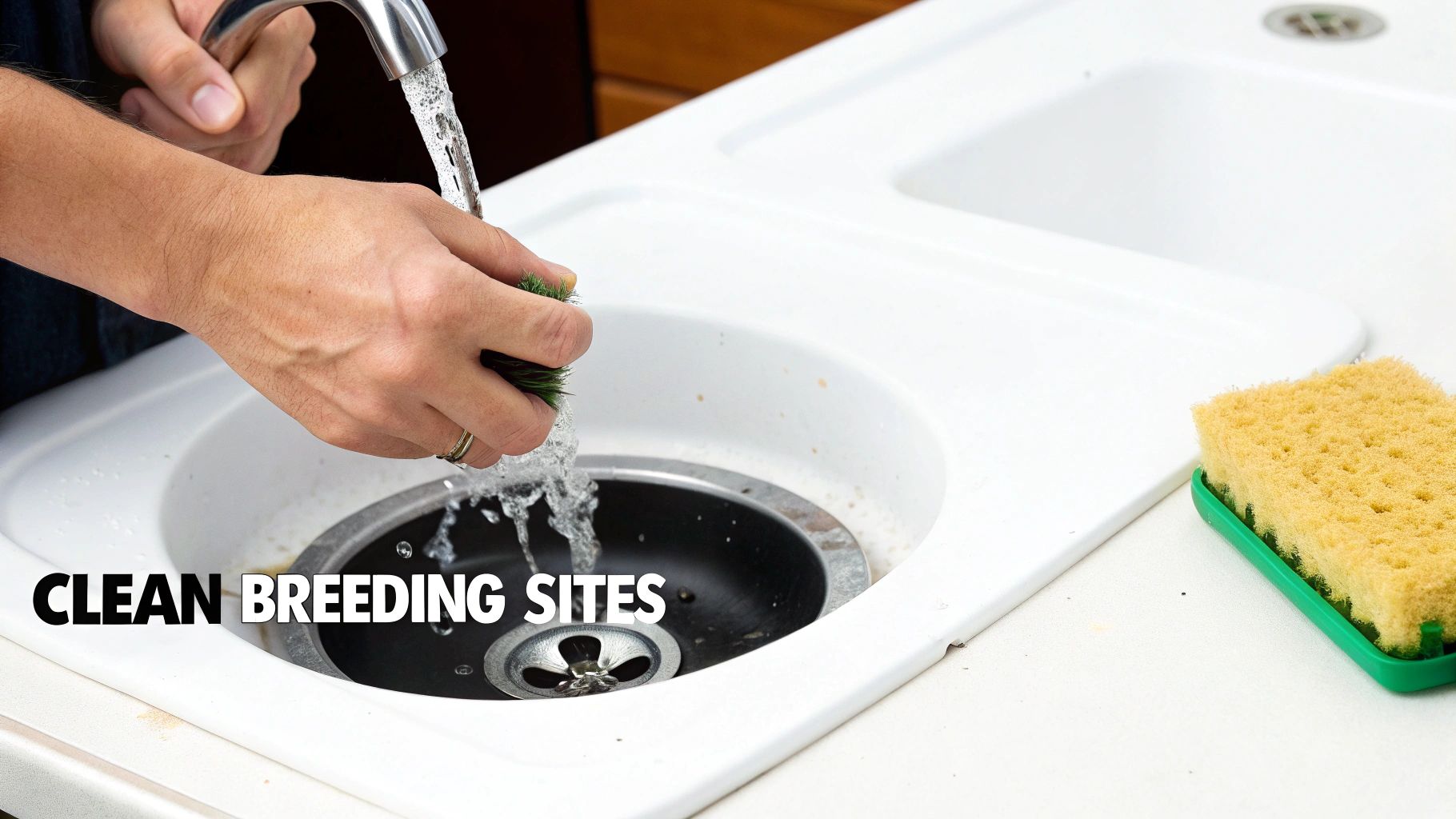
Trapping adult flies is just playing defense. To truly get rid of fruit fly populations, you have to go on offense and destroy their hidden nurseries. A deep clean is your most powerful weapon—and it's more than a simple wipe-down.
This is a strategic mission to make your space completely inhospitable. Think of it like this: adult flies are the soldiers, but the larvae in your drains are the enemy's supply line. Cut the supply line, and the army collapses.
Beyond the Countertop: Hidden Hotspots
Fruit flies are experts at finding obscure, moist places to lay eggs. Your cleaning efforts need to be just as meticulous. The goal is to eliminate both the organic gunk they eat and the moisture they need to reproduce.
Think like a fruit fly. Where would you hide?
- Sink Drains and Garbage Disposals: The slimy biofilm inside your pipes is a five-star hotel for larvae, offering darkness, moisture, and food.
- Damp Sponges and Dish Rags: A wet sponge left in the sink overnight is an open invitation for breeding. Always wring them out completely and hang them to dry.
- Underneath and Behind Appliances: Condensation trays behind refrigerators and crumbs under microwaves are prime real estate for pests.
- Trash and Recycling Bins: It's not just the contents; the sticky residue from a leaky bag or spilled drink provides enough food for a new generation.
A Playbook for Homes and Businesses
The principles are the same for a home kitchen or a busy restaurant, but the scale differs. A single forgotten piece of fruit can lead to an infestation that spreads through an entire dining area.
Key Insight: You can't just clean—you have to sanitize. Cleaning removes crumbs, but sanitizing eliminates the microscopic bacteria and yeast that larvae feed on. This proactive approach is essential for food safety. Check our guide on how to prevent food contamination for more strategies.
For a restaurant, this means strict nightly protocols. Bar mats must be washed and dried, floor drains scrubbed, and soda gun holsters cleaned of all sugary residue. It has to be a non-negotiable part of closing.
Simple, Powerful Cleaning Solutions
You don't need harsh chemicals. A few household staples are highly effective at destroying breeding grounds.
- Boiling Water: Pour a kettle of boiling water down your sink and garbage disposal to kill eggs and larvae in the upper drain.
- Vinegar and Baking Soda: Follow with a half-cup of baking soda, then a cup of white vinegar. The fizzing reaction dislodges stubborn gunk from pipes.
- Thorough Wipedowns: Use a vinegar-and-water solution to wipe down trash cans, under-appliance areas, and countertops to cut through sticky residue.
Fruit flies are tenacious. They are r-selected species, meaning they reproduce incredibly fast under the right conditions, which is why a small problem can explode overnight. To win, you must also implement effective food waste reduction strategies. Limiting their food source from the start prevents the problem from taking hold.
Choosing Traps That Actually Work
Once you've cleaned their breeding spots, it's time to deal with the remaining adult fruit flies. This is where traps come in. A good trap draws in the stragglers and stops them from laying another 300-500 eggs.
The market is flooded with options, but many are ineffective or contain chemicals you don't want near food. Let's focus on two proven methods: a highly effective DIY trap and a look at the best store-bought options.
Create the Ultimate DIY Fruit Fly Trap
You can make a trap that outperforms most store-bought versions for free. The best homemade solution uses two things fruit flies can't resist: the smell of fermentation and a surface they can't escape.
Here’s how to build one that works:
- Grab a small jar or bowl. A mason jar, an old glass, or a disposable cup will do.
- Pour in the bait. Add about an inch of apple cider vinegar. Its fermented aroma is a magnet for fruit flies and works much better than white vinegar.
- Add the secret ingredient. Put two to three drops of dish soap into the vinegar and swirl gently. This is the critical step. The soap breaks the liquid's surface tension, so when flies land to drink, they sink and drown.
- Place it strategically. Put the trap right where the flies congregate—next to the sink, near the garbage can, or beside the fruit bowl.
This simple trap starts working within hours. For a deeper dive into trap designs, check out our complete guide to choosing the best fly trap for fruit flies.
Comparing Commercial Traps
If you prefer a store-bought solution, a couple of good options can help you get rid of fruit fly swarms. They typically fall into two categories, each with its pros and cons.
Expert Tip: Don't rely on a single trap, especially in a large space like a restaurant kitchen. Place multiple traps in different hotspots. One trap can't solve a real infestation alone.
Sticky Traps vs. Light Traps
Let's break down the two most common types.
| Trap Type | How It Works | Best For | Considerations |
|---|---|---|---|
| Sticky Traps | Non-toxic, glue-based traps that use color or a scent to attract flies, which then get stuck to the adhesive surface. | Sticking into potted plants (great for fungus gnats, too) or discreetly on windows. They're silent and odor-free. | They can look unpleasant once covered in dead flies and are less effective in large, open areas. |
| UV Light Traps | These devices use a blue or UV light to lure flying insects. Flies are captured on a hidden glue board or zapped. They are highly effective, especially at night. | Kitchens, bars, and commercial spaces needing 24/7 control. The glow is subtle enough to double as a nightlight. | Requires an outlet and periodic replacement of sticky cartridges or cleaning of the grid. Higher upfront cost. |
Ultimately, a multi-pronged attack is best. Start with a deep clean, set out several DIY traps, and add commercial traps to catch any stragglers. This layered approach is the surest way to get every last one.
Building a Fly-Proof Prevention Routine
After you’ve deep-cleaned the breeding grounds and trapped the last adult flies, the real work begins: making sure they never come back. The secret to keeping your space fly-free isn't a single big clean-up; it's a simple, consistent routine.
Think of it this way: five minutes of daily prevention is far easier than hours battling another infestation. It’s about building simple habits that create a protective barrier.
Daily Habits for a Fly-Free Zone
Consistency is your superpower against fruit flies. A few small actions each day can shut down their life cycle before it starts.
Incorporate these tasks into your daily kitchen cleanup:
- Wipe Down Surfaces Immediately: Don't let spills or crumbs linger. A quick wipe-down with a vinegar-and-water spray removes the sugary film they love.
- Rinse All Recyclables: Give cans, bottles, and jars a quick rinse. The last drop of soda or juice is a beacon for fruit flies.
- Manage Your Fruit Bowl: Move ripe fruit to the refrigerator. Use, freeze, or compost any produce that’s getting soft right away.
Key Takeaway: A fruit fly can go from egg to adult in just 8-10 days. Slacking off for even a day or two gives them a window to lay hundreds of eggs and restart the cycle.
Weekly Maintenance and Commercial Protocols
For a bulletproof defense, add a few weekly tasks to your checklist. If you're running a restaurant or venue, these should be standard operating procedures (SOPs).
Once a week, pour boiling water or an approved drain cleaner down every sink to break down the biofilm where larvae hide. Take out all trash and recycling daily, and scrub the bins themselves at least once a week to remove any sticky residue.
A solid prevention routine is crucial. The same principles apply to other common household issues; learn more about preventative strategies for household pests by tackling their root causes.
Don't underestimate the scale of this problem. The global fruit fly control market was valued at around $5 billion in 2019 and continues to grow. This figure shows just how vital a good prevention plan is for homes and businesses.
By making these habits automatic, you create an environment where fruit flies simply can't survive, let alone thrive.
A Modern Approach to Fly-Free Spaces
You've planned the perfect outdoor event. The restaurant patio is buzzing, or the backyard barbecue is starting. The last thing you want is a swarm of fruit flies dive-bombing the food and annoying your guests.
We’ve all tried the old tricks. Sticky traps look awful, vinegar bowls are messy, and you can't spray chemicals around food.
It's time for a different strategy. Instead of trapping flies after they arrive, what if you could create an invisible shield to stop them from landing in the first place? This is a proactive, clean, and elegant way to protect your dining areas.
The Science of Disruption
The smartest solutions today don't kill flies—they convince them to go elsewhere. Battery-operated fly fans, for example, use soft, spinning blades to create a gentle air current. For a tiny insect like a fruit fly, flying through that is like a person walking through a hurricane. They can't do it.
The real magic is the visual trickery. The blades on these fans often have a special holographic pattern. As they spin, the pattern refracts light, creating a shimmering, confusing visual field.
To a fruit fly's compound eyes, this moving light show is completely disorienting. They perceive it as a threat or a solid wall, triggering their instinct to stay away. It’s a silent, harmless, and shockingly effective way to get rid of fruit fly problems at any gathering.
Of course, any active deterrent works best when you've already handled the basics. This infographic is a great reminder of the foundational steps.
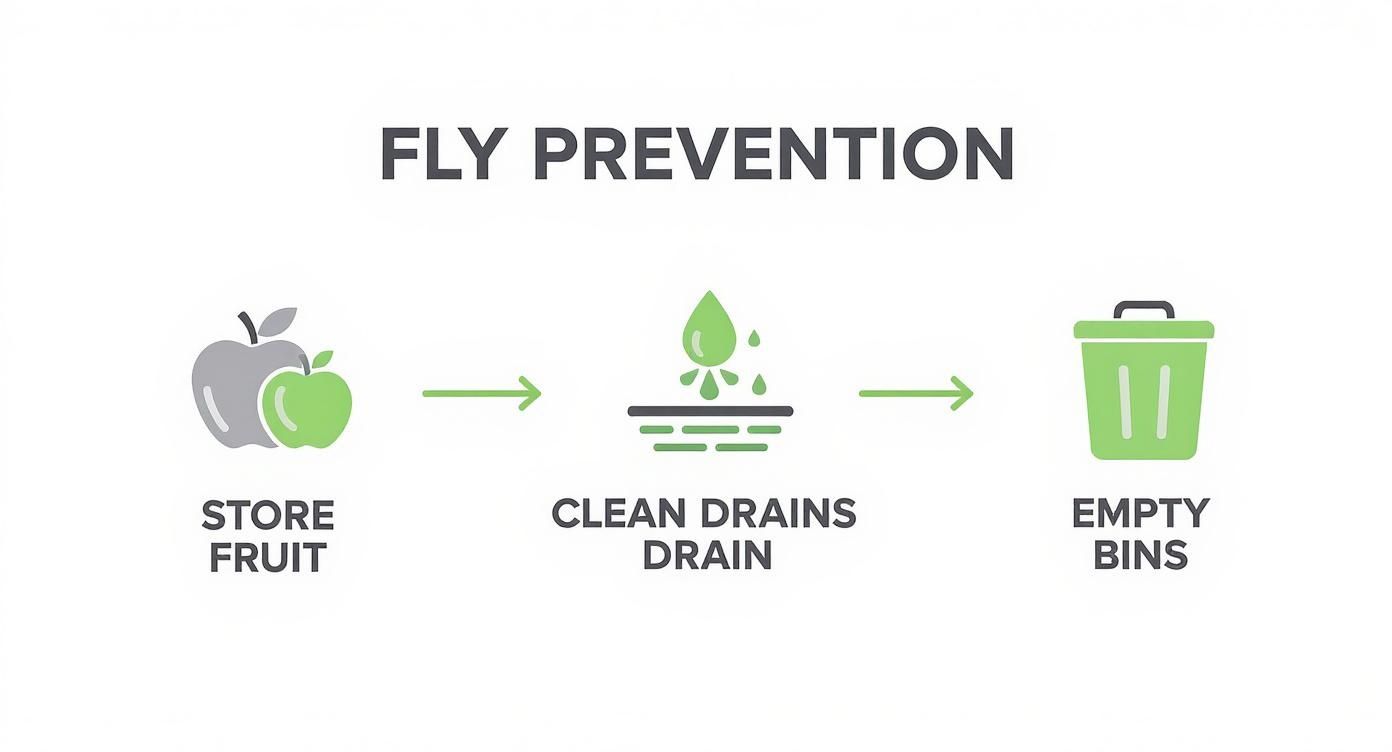
As you can see, managing fruit, drains, and trash is step one. That alone will make your space far less attractive to these pests.
Where Fly Fans Really Shine: Real-World Scenarios
The beauty of this technology is its flexibility. These fans are portable, quiet, and don't ruin the ambiance. Just place them where you need them.
Here are a few ways they are used effectively:
- Restaurant Patios: A single fan on each table provides a peaceful, pest-free meal and enhances the customer experience.
- Catered Events and Buffets: Placing a few fans along the buffet line creates a protected zone over the food, keeping it fresh and appetizing.
- Home Barbecues: Keep one next to the grill where you prep food and another on the picnic table. Simple and effective.
To see how they're designed for these situations, you can check out the features of the Modern Lyfe fly fan.
Modern Lyfe Fly Fan vs. Traditional Methods
When you compare the options, it's clear why a modern deterrent is the better choice for protecting food and people. They are a clean, proactive alternative to messy, reactive traps.
Here's a quick comparison.
| Feature | Modern Lyfe Fly Fan | DIY Vinegar Trap | Sticky Traps |
|---|---|---|---|
| Method | Deters flies with air and light | Drowns flies in liquid | Captures flies on adhesive |
| Appearance | Sleek and unobtrusive | Messy bowl of liquid | Unsightly and covered in dead flies |
| Best For | Outdoor dining, buffets, events | Small, localized indoor spots | Discreet indoor corners, potted plants |
| Chemicals | 100% Chemical-free | None | None |
| Safety | Soft blades stop on contact | Spills can attract other pests | Can stick to unintended surfaces |
This modern approach gives you peace of mind, letting you focus on your guests and enjoy the moment, knowing your food is protected by a smart, simple, and effective solution.
Your Top Fruit Fly Questions, Answered
If you're dealing with a fruit fly problem, you probably have questions. You’ve cleaned and set traps, but the pests are still around. It's frustrating. Let's tackle some of the most common questions to help you win the fight.
Where Did These Fruit Flies Even Come From?
This is usually the first question. It can feel like they materialized out of thin air. The truth is, you most likely brought them home yourself.
The main culprit is grocery store produce. A female fruit fly lays her nearly invisible eggs on the skin of ripening fruits and vegetables. You bring that produce home, and as it sits on your counter, the eggs hatch. Suddenly, you have an infestation from a single piece of fruit.
Why Do They Seem to Multiply Overnight?
You're not imagining it. Their population can explode in what feels like a day or two, thanks to their incredibly fast life cycle.
A single female can lay up to 500 eggs. In a warm kitchen with plenty of food, those eggs can go from hatching to reproducing adults in as little as 8 to 10 days. This exponential growth is why you need to act fast.
The secret is breaking their life cycle. If you're only swatting adults, you’re missing the hundreds of eggs and larvae in hidden spots. You have to attack both at the same time.
Are They Really Coming Up Through My Drains?
Yes, they can. While they probably aren't coming from the city sewer, your kitchen and floor drains are perfect breeding grounds. The slimy biofilm coating the inside of your pipes is a dark, damp, food-rich nursery for their larvae.
Adults are drawn to the scent of decay from the drain. They fly down, lay eggs in the gunk, and a new generation emerges. Pouring boiling water down your drains a few times a week is a simple, effective way to sterilize the pipes and disrupt this cycle.
Do Those DIY Vinegar Traps Actually Work?
Some work surprisingly well. The popular trap made with apple cider vinegar and a drop of dish soap is a classic for a reason—it's effective. The fermented vinegar smell attracts flies, and the soap breaks the liquid's surface tension, causing them to fall in and drown.
Other home remedies, like a bowl of red wine, can be hit or miss. For any serious infestation, a single trap isn't enough. You need a combined strategy: a thorough deep clean to remove food sources, plus several well-placed traps to catch any remaining adults.
Ready to stop swatting and enjoy a fly-free space? For protecting your dining areas without smelly chemicals or ugly traps, the best modern solution is a fly fan from MODERN LYFE. Their stylish design creates a gentle, fly-deterring barrier that keeps pests off your food and away from your guests. It's the perfect touch for a quiet patio dinner or a big, bustling event. Discover the difference and reclaim your space at modernlyfe.com.

